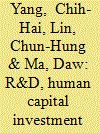|
|
|
Sort Order |
|
|
|
Items / Page
|
|
|
|
|
|
|
| Srl | Item |
| 1 |
ID:
121743


|
|
|
|
|
| Publication |
2013.
|
| Summary/Abstract |
This study uses an unbalanced panel data analysis to examine the effects of social capital, top executive attributes and R&D on firm value in Chinese small and medium-sized enterprises (SMEs) listed on the Shenzhen Stock Exchange Small and Medium-sized Enterprises Board from 2007 to 2011. There are several interesting findings. First, the gender (male) and academic degree of the chairperson in the SMEs have a positive and significant effect on firm value. Second, social capital (measured by political connections, managerial business association networks and technology association networks) and R&D have a positive effect on SME firm value. Third, the effect of political connections on firm value for state-owned enterprises (SOEs) is stronger than for non-SOEs, while the effect of business and technology networks on firm value for non-SOEs is stronger than for SOEs. Our study has important policy implications for SMEs that want to compete successfully in China.
|
|
|
|
|
|
|
|
|
|
|
|
|
|
|
|
| 2 |
ID:
112724


|
|
|
|
|
| Publication |
2012.
|
| Summary/Abstract |
Recently, Foreign Invested Enterprises (FIEs) in China have increased their investment in not only production activity but also R&D activity. This paper examines the impact of spillovers from such activities by FIEs on two types of innovations by Chinese domestic firms: Total Factor Productivity (TFP) and invention patent application, using comprehensive industry and province-level data. We evaluate such spillovers according to FIEs' ownership structure, the origin of foreign funds and whether they are from the same industry or from other industries. We find an interesting asymmetry between spillovers to TFP and invention patent applications; while we do not find significant intra-industry spillovers from FIEs but find robust inter-industries spillover related to TFP, we find substantial intra-industry spillovers promoting invention patent applications but no evidence of inter-industries spillovers. Furthermore, whereas spillovers from FIEs to Chinese firms' TFP stem from their production activities, the source of spillovers related to invention patent applications is mostly through their R&D activity. Our findings indicate a need for multidimensional evaluation of the role of FDI in developing countries.
|
|
|
|
|
|
|
|
|
|
|
|
|
|
|
|
| 3 |
ID:
108001


|
|
|
|
|
| Publication |
2011.
|
| Summary/Abstract |
This paper aims to systematically investigate the impacts of strengthening intellectual property rights on patenting in China's high-technology industries and to explore the potential differences in response to patent reform by ownership. Empirical results show that the estimated patent elasticity of R&D is lower than that for OECD countries, indicating relatively low R&D productivity for China's high-technology industries. The direct innovation effect of technology imports is negative, while the absorptive ability embodied in R&D helps in gaining external sources of knowledge, thus contributing to innovations. Specifically, strengthening intellectual property rights can induce more innovations in terms of patents in China's high-technology industries and is particularly relevant to foreign-owned high-technology enterprises.
|
|
|
|
|
|
|
|
|
|
|
|
|
|
|
|
| 4 |
ID:
104956


|
|
|
|
|
| Publication |
2011.
|
| Summary/Abstract |
This paper estimates the social rate of return to research and development (R&D) in the energy manufacturing industry. Our model tries to quantify the positive contribution that lagged R&D has on total factor productivity (TFP) growth in the manufacturing of coal, petroleum products and nuclear fuel for a number of OECD countries. Using a panel of data from the OECD STAN database we are able to obtain results suggesting that R&D has a positive and significant rate of return that varies for each country.
|
|
|
|
|
|
|
|
|
|
|
|
|
|
|
|
| 5 |
ID:
099163


|
|
|
|
|
| Publication |
2010.
|
| Summary/Abstract |
Using firm-level panel data covering 2005-2007, the present paper examines the effects of R&D and human capital investment on productivity in China's electronics industry. It is found that both R&D and on-the-job training positively contribute to total factor productivity (TFP). Firms' investment in employees' health insurance and pensions, which are components of workers' compensation, generate a productivity-enhancing effect, supporting the efficiency wage hypothesis. The estimated impact of R&D on productivity varies among different forms of ownership, and foreign-owned enterprises experience higher R&D efficiency than state or private enterprises. After controlling for potential endogenous causality between TFP and R&D, the above findings remain unchanged. We also find that on-the-job training can improve the quality of human capital and is helpful in promoting productivity. Therefore, establishing indigenous technological capability through various technological sources is quite important, and the government should devote further effort to investing in human capital.
|
|
|
|
|
|
|
|
|
|
|
|
|
|
|
|
| 6 |
ID:
101382


|
|
|
|
|
| Publication |
2011.
|
| Summary/Abstract |
This paper aims to perform a real options valuation of fusion energy R&D programme. Strategic value of thermonuclear fusion technology is estimated here based on the expected cash flows from construction and operation of fusion power plants and the real options value arising due to managerial flexibility and the underlying uncertainty. First, a basic investment option model of Black-Scholes type is being considered. Then, a fuzzy compound real R&D option model is elaborated, which reflects in a better way the multi-stage nature of the programme and takes into account the imprecision of information as one of the components of the overall programme uncertainty. Two different strategies are compared: "Baseline" corresponding to a relatively moderate pace of fusion research, development, demonstration and deployment activities vs. "Accelerated" strategy, which assumes a rapid demonstration and massive deployment of fusion. The conclusions are drawn from the model calculations regarding the strategic value of fusion energy R&D and the advantages of accelerated development path.
|
|
|
|
|
|
|
|
|
|
|
|
|
|
|
|
|
|
|
|
|